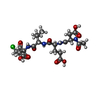+ Open data
Open data
- Basic information
Basic information
| Entry | Database: PDB / ID: 5i9t | ||||||
|---|---|---|---|---|---|---|---|
| Title | Caspase 3 V266C | ||||||
 Components Components |
| ||||||
 Keywords Keywords | Hydrolase/Hydrolase Inhibitor /  Allostery / Allostery /  saturation mutagenesis / conformational selection / native ensemble / protein solvation / saturation mutagenesis / conformational selection / native ensemble / protein solvation /  protein structure / protein structure /  protein dynamics / Hydrolase-Hydrolase Inhibitor complex protein dynamics / Hydrolase-Hydrolase Inhibitor complex | ||||||
| Function / homology |  Function and homology information Function and homology information caspase-3 / Stimulation of the cell death response by PAK-2p34 / phospholipase A2 activator activity / anterior neural tube closure / intrinsic apoptotic signaling pathway in response to osmotic stress / leukocyte apoptotic process / positive regulation of pyroptotic inflammatory response / glial cell apoptotic process / NADE modulates death signalling / caspase-3 / Stimulation of the cell death response by PAK-2p34 / phospholipase A2 activator activity / anterior neural tube closure / intrinsic apoptotic signaling pathway in response to osmotic stress / leukocyte apoptotic process / positive regulation of pyroptotic inflammatory response / glial cell apoptotic process / NADE modulates death signalling /  luteolysis ... luteolysis ... caspase-3 / Stimulation of the cell death response by PAK-2p34 / phospholipase A2 activator activity / anterior neural tube closure / intrinsic apoptotic signaling pathway in response to osmotic stress / leukocyte apoptotic process / positive regulation of pyroptotic inflammatory response / glial cell apoptotic process / NADE modulates death signalling / caspase-3 / Stimulation of the cell death response by PAK-2p34 / phospholipase A2 activator activity / anterior neural tube closure / intrinsic apoptotic signaling pathway in response to osmotic stress / leukocyte apoptotic process / positive regulation of pyroptotic inflammatory response / glial cell apoptotic process / NADE modulates death signalling /  luteolysis / response to cobalt ion / cysteine-type endopeptidase activity involved in apoptotic signaling pathway / luteolysis / response to cobalt ion / cysteine-type endopeptidase activity involved in apoptotic signaling pathway /  death-inducing signaling complex / cyclin-dependent protein serine/threonine kinase inhibitor activity / cellular response to staurosporine / Apoptosis induced DNA fragmentation / Apoptotic cleavage of cell adhesion proteins / cysteine-type endopeptidase activity involved in execution phase of apoptosis / Caspase activation via Dependence Receptors in the absence of ligand / death-inducing signaling complex / cyclin-dependent protein serine/threonine kinase inhibitor activity / cellular response to staurosporine / Apoptosis induced DNA fragmentation / Apoptotic cleavage of cell adhesion proteins / cysteine-type endopeptidase activity involved in execution phase of apoptosis / Caspase activation via Dependence Receptors in the absence of ligand /  death receptor binding / SMAC, XIAP-regulated apoptotic response / axonal fasciculation / Activation of caspases through apoptosome-mediated cleavage / Signaling by Hippo / SMAC (DIABLO) binds to IAPs / SMAC(DIABLO)-mediated dissociation of IAP:caspase complexes / cysteine-type endopeptidase activity involved in apoptotic process / fibroblast apoptotic process / execution phase of apoptosis / negative regulation of cytokine production / epithelial cell apoptotic process / platelet formation / Other interleukin signaling / positive regulation of amyloid-beta formation / pyroptotic inflammatory response / Apoptotic cleavage of cellular proteins / negative regulation of B cell proliferation / T cell homeostasis / negative regulation of activated T cell proliferation / neurotrophin TRK receptor signaling pathway / B cell homeostasis / protein maturation / negative regulation of cell cycle / response to X-ray / Caspase-mediated cleavage of cytoskeletal proteins / death receptor binding / SMAC, XIAP-regulated apoptotic response / axonal fasciculation / Activation of caspases through apoptosome-mediated cleavage / Signaling by Hippo / SMAC (DIABLO) binds to IAPs / SMAC(DIABLO)-mediated dissociation of IAP:caspase complexes / cysteine-type endopeptidase activity involved in apoptotic process / fibroblast apoptotic process / execution phase of apoptosis / negative regulation of cytokine production / epithelial cell apoptotic process / platelet formation / Other interleukin signaling / positive regulation of amyloid-beta formation / pyroptotic inflammatory response / Apoptotic cleavage of cellular proteins / negative regulation of B cell proliferation / T cell homeostasis / negative regulation of activated T cell proliferation / neurotrophin TRK receptor signaling pathway / B cell homeostasis / protein maturation / negative regulation of cell cycle / response to X-ray / Caspase-mediated cleavage of cytoskeletal proteins /  regulation of macroautophagy / response to amino acid / regulation of macroautophagy / response to amino acid /  cell fate commitment / cell fate commitment /  Pyroptosis / response to tumor necrosis factor / response to glucose / response to UV / response to glucocorticoid / keratinocyte differentiation / striated muscle cell differentiation / Degradation of the extracellular matrix / intrinsic apoptotic signaling pathway / Pyroptosis / response to tumor necrosis factor / response to glucose / response to UV / response to glucocorticoid / keratinocyte differentiation / striated muscle cell differentiation / Degradation of the extracellular matrix / intrinsic apoptotic signaling pathway /  erythrocyte differentiation / response to nicotine / apoptotic signaling pathway / hippocampus development / sensory perception of sound / protein catabolic process / erythrocyte differentiation / response to nicotine / apoptotic signaling pathway / hippocampus development / sensory perception of sound / protein catabolic process /  regulation of protein stability / response to hydrogen peroxide / protein processing / neuron differentiation / response to wounding / positive regulation of neuron apoptotic process / response to estradiol / regulation of protein stability / response to hydrogen peroxide / protein processing / neuron differentiation / response to wounding / positive regulation of neuron apoptotic process / response to estradiol /  heart development / heart development /  peptidase activity / neuron apoptotic process / peptidase activity / neuron apoptotic process /  protease binding / response to lipopolysaccharide / aspartic-type endopeptidase activity / response to hypoxia / learning or memory / response to xenobiotic stimulus / positive regulation of apoptotic process / cysteine-type endopeptidase activity / neuronal cell body / apoptotic process / DNA damage response / protein-containing complex binding / protease binding / response to lipopolysaccharide / aspartic-type endopeptidase activity / response to hypoxia / learning or memory / response to xenobiotic stimulus / positive regulation of apoptotic process / cysteine-type endopeptidase activity / neuronal cell body / apoptotic process / DNA damage response / protein-containing complex binding /  proteolysis / proteolysis /  nucleoplasm / nucleoplasm /  nucleus / nucleus /  cytosol / cytosol /  cytoplasm cytoplasmSimilarity search - Function | ||||||
| Biological species |   Homo sapiens (human) Homo sapiens (human)unidentified (others) | ||||||
| Method |  X-RAY DIFFRACTION / X-RAY DIFFRACTION /  SYNCHROTRON / Resolution: 1.95 Å SYNCHROTRON / Resolution: 1.95 Å | ||||||
 Authors Authors | Maciag, J.J. / Mackenzie, S.H. / Tucker, M.B. / Schipper, J.L. / Swartz, P.D. / Clark, A.C. | ||||||
 Citation Citation |  Journal: Proc.Natl.Acad.Sci.USA / Year: 2016 Journal: Proc.Natl.Acad.Sci.USA / Year: 2016Title: Tunable allosteric library of caspase-3 identifies coupling between conserved water molecules and conformational selection. Authors: Maciag, J.J. / Mackenzie, S.H. / Tucker, M.B. / Schipper, J.L. / Swartz, P. / Clark, A.C. | ||||||
| History |
|
- Structure visualization
Structure visualization
| Structure viewer | Molecule:  Molmil Molmil Jmol/JSmol Jmol/JSmol |
|---|
- Downloads & links
Downloads & links
- Download
Download
| PDBx/mmCIF format |  5i9t.cif.gz 5i9t.cif.gz | 117.3 KB | Display |  PDBx/mmCIF format PDBx/mmCIF format |
|---|---|---|---|---|
| PDB format |  pdb5i9t.ent.gz pdb5i9t.ent.gz | 95.2 KB | Display |  PDB format PDB format |
| PDBx/mmJSON format |  5i9t.json.gz 5i9t.json.gz | Tree view |  PDBx/mmJSON format PDBx/mmJSON format | |
| Others |  Other downloads Other downloads |
-Validation report
| Arichive directory |  https://data.pdbj.org/pub/pdb/validation_reports/i9/5i9t https://data.pdbj.org/pub/pdb/validation_reports/i9/5i9t ftp://data.pdbj.org/pub/pdb/validation_reports/i9/5i9t ftp://data.pdbj.org/pub/pdb/validation_reports/i9/5i9t | HTTPS FTP |
|---|
-Related structure data
| Related structure data | 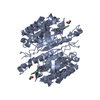 5i9bC  5iabC 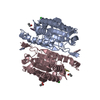 5iaeC 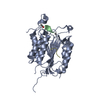 5iagC 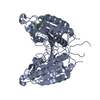 5iajC  5iakC 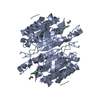 5ianC 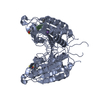 5iarC 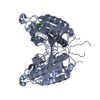 5iasC 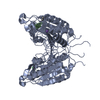 5ibcC 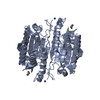 5ibpC  5ibrC C: citing same article ( |
|---|---|
| Similar structure data |
- Links
Links
- Assembly
Assembly
| Deposited unit | 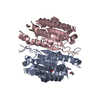
| ||||||||
|---|---|---|---|---|---|---|---|---|---|
| 1 |
| ||||||||
| Unit cell |
|
- Components
Components
| #1: Protein |  Caspase 3 / CASP-3 / Apopain / Cysteine protease CPP32 / CPP-32 / Protein Yama / SREBP cleavage activity 1 / SCA-1 Caspase 3 / CASP-3 / Apopain / Cysteine protease CPP32 / CPP-32 / Protein Yama / SREBP cleavage activity 1 / SCA-1Mass: 31769.105 Da / Num. of mol.: 2 / Mutation: V266C Source method: isolated from a genetically manipulated source Source: (gene. exp.)   Homo sapiens (human) / Gene: CASP3, CPP32 Homo sapiens (human) / Gene: CASP3, CPP32Production host:   Escherichia coli str. 'clone D i14' (bacteria) Escherichia coli str. 'clone D i14' (bacteria)References: UniProt: P42574,  caspase-3 caspase-3#2: Protein/peptide | #3: Chemical | ChemComp-ACT / |  Acetate Acetate#4: Water | ChemComp-HOH / |  Water Water |
|---|
-Experimental details
-Experiment
| Experiment | Method:  X-RAY DIFFRACTION / Number of used crystals: 1 X-RAY DIFFRACTION / Number of used crystals: 1 |
|---|
- Sample preparation
Sample preparation
| Crystal | Density Matthews: 2.14 Å3/Da / Density % sol: 42.43 % |
|---|---|
Crystal grow | Temperature: 291 K / Method: vapor diffusion, hanging drop / pH: 8.5 Details: Caspase-3 variants were crystallized in the presence of Ac-DEVD-CMK. PROTEINS WERE DIALYZED IN A BUFFER OF 10 MM TRIS-HCL, PH 8.5, 1 MM DTT. THE PROTEIN WAS CONCENTRATED TO 10 MG/ML USING ...Details: Caspase-3 variants were crystallized in the presence of Ac-DEVD-CMK. PROTEINS WERE DIALYZED IN A BUFFER OF 10 MM TRIS-HCL, PH 8.5, 1 MM DTT. THE PROTEIN WAS CONCENTRATED TO 10 MG/ML USING AMICON ULTRAFREE CENTRIFUGAL FILTER DEVICES, AND INHIBITOR, AC-DEVD-CMK RECONSTITUTED IN DMSO, WAS THEN ADDED AT 5:1 WT:WT, INHIBITOR TO PEPTIDE. THE PROTEIN WAS DILUTED TO A CONCENTRATION OF 8 MG/ML BY ADDING 10 MM TRIS-HCL, PH 8.5, CONCENTRATED DTT AND CONCENTRATED NAN3 SO THAT THE FINAL BUFFER WAS 10 MM TRIS-HCL, PH 8.5, 10 MM DTT, 3 MM NAN3. 2 UL OF CONCENTRATED PROTEIN WAS MIXED 1:1 WITH WELL BUFFER THAT CONTAINED 100 MM SODIUM CITRATE, PH 5, 3 MM NAN3, 10 MM DTT AND 17% PEG 6000 W/V. SOLUTIONS WERE INCUBATED AT 18 DEG C USING THE HANGING DROP METHOD. CRYSTALS GREW WITHIN THREE DAYS FOR WILD- TYPE CASPASE-3 AND WITHIN TWO WEEKS FOR THE MUTANTS. |
-Data collection
| Diffraction | Mean temperature: 100 K |
|---|---|
| Diffraction source | Source:  SYNCHROTRON / Site: SYNCHROTRON / Site:  APS APS  / Beamline: 22-BM / Wavelength: 1 Å / Beamline: 22-BM / Wavelength: 1 Å |
| Detector | Type: MARMOSAIC 225 mm CCD / Detector: CCD / Date: Dec 12, 2014 |
| Radiation | Protocol: SINGLE WAVELENGTH / Monochromatic (M) / Laue (L): M / Scattering type: x-ray |
| Radiation wavelength | Wavelength : 1 Å / Relative weight: 1 : 1 Å / Relative weight: 1 |
| Reflection | Resolution: 1.949→33.581 Å / Num. obs: 39516 / % possible obs: 99.6 % / Redundancy: 3.8 % / Net I/σ(I): 1.34 |
- Processing
Processing
| Software |
| |||||||||||||||||||||||||||||||||||||||||||||||||||||||||||||||||||||||||||||||||||||||||||||||||||||||||
|---|---|---|---|---|---|---|---|---|---|---|---|---|---|---|---|---|---|---|---|---|---|---|---|---|---|---|---|---|---|---|---|---|---|---|---|---|---|---|---|---|---|---|---|---|---|---|---|---|---|---|---|---|---|---|---|---|---|---|---|---|---|---|---|---|---|---|---|---|---|---|---|---|---|---|---|---|---|---|---|---|---|---|---|---|---|---|---|---|---|---|---|---|---|---|---|---|---|---|---|---|---|---|---|---|---|---|
| Refinement | Resolution: 1.95→33.58 Å / SU ML: 0.2 / Cross valid method: THROUGHOUT / σ(F): 1.34 / Phase error: 20.01 Details: Authors state that there is a fundamental incompatibility in the naming of the inhibitor structure and the refinement program cannot be made to establish a bond that exists between the ...Details: Authors state that there is a fundamental incompatibility in the naming of the inhibitor structure and the refinement program cannot be made to establish a bond that exists between the inhibitor and the protein at the active site cysteine.
| |||||||||||||||||||||||||||||||||||||||||||||||||||||||||||||||||||||||||||||||||||||||||||||||||||||||||
| Solvent computation | Shrinkage radii: 0.9 Å / VDW probe radii: 1.11 Å | |||||||||||||||||||||||||||||||||||||||||||||||||||||||||||||||||||||||||||||||||||||||||||||||||||||||||
| Refinement step | Cycle: LAST / Resolution: 1.95→33.58 Å
| |||||||||||||||||||||||||||||||||||||||||||||||||||||||||||||||||||||||||||||||||||||||||||||||||||||||||
| Refine LS restraints |
| |||||||||||||||||||||||||||||||||||||||||||||||||||||||||||||||||||||||||||||||||||||||||||||||||||||||||
| LS refinement shell |
|
 Movie
Movie Controller
Controller



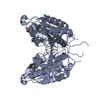
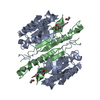
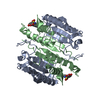

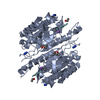





 PDBj
PDBj















